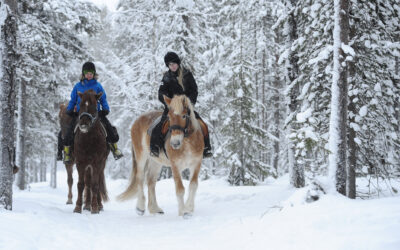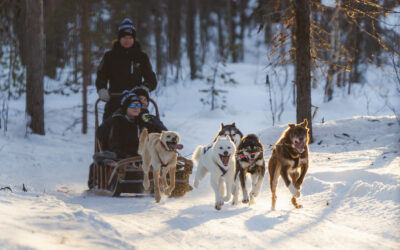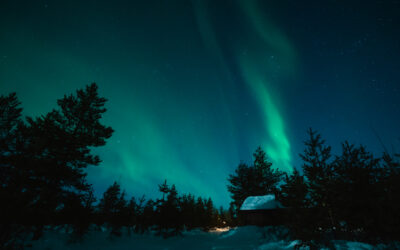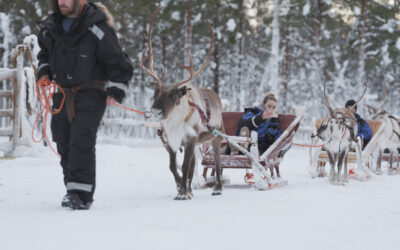For a winter reindeer safari in Finnish Lapland, proper layering is important. Start with a moisture-wicking base layer, add an insulating mid-layer of wool or fleece, and top with a windproof, waterproof outer shell. Extremity protection is really important: wear insulated, waterproof boots, thermal gloves or mittens, a warm hat, and a neck gaiter. Don’t forget thermal underwear, wool socks, and sunglasses for snow glare. We provide thermal overalls and boots, but bring your own base and mid-layers for personal comfort in temperatures that can drop below -30°C.
Understanding the basics: what is a reindeer safari experience?
A reindeer safari is a traditional Arctic adventure where you glide through snow-covered forests and across frozen lakes in a sleigh pulled by reindeer. These magical experiences typically last between 30 minutes to several hours, immersing you in the pristine winter wilderness of Finnish Lapland where temperatures commonly range from -10°C to -30°C.
During your safari, you’ll experience the enchanting silence of Lapland’s winter wonderland, broken only by the soft padding of reindeer hooves and the gentle swoosh of runners on snow. The serene pace allows you to fully absorb the breathtaking beauty of snow-laden trees and the crisp, clean air that defines the Arctic environment.
Proper clothing isn’t just about comfort—it’s a safety necessity. The extreme cold of the Arctic winter can pose serious risks like frostbite and hypothermia if you’re inadequately dressed. Additionally, you’ll be relatively stationary in the sleigh, which means your body generates less heat than during active pursuits. Explore our authentic reindeer experiences to discover the magic of Lapland while gliding through the stunning winter landscape.
The unique winter conditions of Lapland—with its short daylight hours, potential for snowfall, and the possibility of witnessing the northern lights during evening safaris—require specific clothing considerations to ensure your experience remains comfortable and memorable for all the right reasons.
What are the three important clothing layers for a winter reindeer safari?
The three-layer clothing system is the foundation of staying warm during your reindeer safari: base layer for moisture management, mid layer for insulation, and outer layer for weather protection. This strategic layering creates trapped air pockets that retain body heat while allowing adaptability to changing conditions.
Your base layer should consist of thermal underwear made from synthetic materials like polyester or natural fibres like merino wool. These fabrics wick moisture away from your skin, preventing the chilling effect of sweat. Avoid cotton at all costs, as it retains moisture and can rapidly cool your body once wet. Long-sleeved tops and full-length bottoms provide complete coverage.
The mid layer’s primary purpose is insulation. Fleece, wool, or down garments trap warm air close to your body. For maximum warmth, consider multiple thin mid layers rather than one thick one—this approach creates more insulating air pockets and offers flexibility if temperatures change. Wool retains its insulating properties even when damp, making it particularly valuable in winter conditions.
Your outer layer must be both windproof and waterproof while remaining breathable to prevent condensation of body moisture. Look for jackets and trousers with sealed seams, storm flaps over zippers, and adjustable cuffs and hems to prevent cold air infiltration. Many quality outdoor garments use membranes like Gore-Tex that block wind and water while allowing perspiration to escape.
The effectiveness of this system lies in how these layers work together. The base layer keeps you dry, the mid layer keeps you warm, and the outer layer shields you from the elements. When properly implemented, this approach maintains your core temperature even in the challenging Arctic conditions you’ll encounter during your reindeer safari through Lapland’s magical winter landscape.
Which extremity protection is most important for arctic activities?
For Arctic activities like reindeer safaris, comprehensive extremity protection is vital, with hands and feet requiring the most attention as they’re particularly vulnerable to frostbite. Proper circulation to these areas is naturally limited in extreme cold, making specialized gear important for safety and comfort.
For hands, choose insulated, waterproof mittens over gloves whenever possible. Mittens keep fingers together, allowing them to share warmth, and provide better insulation than individual finger compartments. Consider a two-layer approach: thin liner gloves underneath waterproof, insulated mittens. This combination allows brief exposure for taking photos or handling equipment without completely exposing your hands to the cold.
Feet require equally careful consideration. Start with thin liner socks followed by thick wool or synthetic thermal socks. Never double up with two thick pairs, as this can restrict circulation and actually make your feet colder. Your boots should be insulated, waterproof, and rated for extreme cold (typically to at least -30°C). Look for features like removable liners, reflective insoles, and thick rubber soles that provide insulation from the frozen ground.
Head protection should include a warm wool or fleece hat that covers your ears completely. Up to 30% of body heat can be lost through an uncovered head, making this simple item surprisingly important. For full protection in the harshest conditions, consider a balaclava or neck gaiter that can be pulled up to cover your face, leaving only your eyes exposed. This protects delicate facial skin from frostbite and shields your airways from the shock of extremely cold air.
Eye protection is often overlooked but necessary, particularly during daytime safaris. The combination of low winter sun and reflective snow creates intense glare that can cause snow blindness. Sunglasses with UV protection or, in very cold conditions, ski goggles will protect your eyes while improving visibility in bright conditions.
Remember that your extremities are the first to suffer in cold conditions, so investing in quality protection for hands, feet, head, and face should be a priority when preparing for your Arctic adventure. Book your winter adventure with confidence knowing you’ll be properly prepared for the magical Lapland environment.
What clothing do we provide versus what should you bring yourself?
At Polar Lights Tours, we can provide outer layer equipment for winter safaris, while personal base and mid-layers remain your responsibility. Understanding this division helps you pack efficiently for your Arctic adventure.
The items we provide include thermal overalls—the one-piece insulated suits that serve as an excellent outer layer. These are designed specifically for Arctic conditions and provide comprehensive insulation and wind protection. We can also supply insulated winter boots rated for extreme temperatures, saving you significant luggage space and the expense of purchasing specialized footwear you might rarely use elsewhere.
You should bring your own thermal underwear (base layers) for both top and bottom. These items contact your skin directly, so having your own for hygiene reasons is preferable. Additionally, quality moisture-wicking base layers in the correct size are useful for comfort and temperature regulation.
Mid-layers are also your responsibility. Pack fleece or wool jumpers, insulated trousers, and multiple options to adjust to varying conditions. These personal items allow you to customize your layering system according to your individual cold tolerance, which varies significantly between people.
For accessories, bring your own thin glove liners, neck gaiter or scarf, and sunglasses. While some of these might be available from us, having your own ensures proper fit and personal comfort. Thin liner socks to wear under thicker socks are also recommended.
If you’re planning to photograph the northern lights, specialized photography gloves are worth investing in, as these aren’t typically provided. Similarly, if you have specific medical needs related to cold weather, bring appropriate personal items like hand warmers or specialized insoles.
Before your trip, contact our friendly team for specific information about what gear is included with your booking. We can provide detailed guidance about what to bring based on the forecasted conditions during your visit and the specific activities you’ve scheduled. Many items can also be purchased locally if needed, though selection may be limited in smaller villages.
Key takeaways: how to prepare for your winter reindeer safari adventure
Preparing properly for your winter reindeer safari means understanding that appropriate clothing is not just about comfort—it’s about safely enjoying the magical Arctic experience. The right gear transforms potentially harsh conditions into a memorable adventure through Lapland’s winter wonderland.
Remember the foundational three-layer system: moisture-wicking base layers, insulating mid-layers, and protective outer layers. This approach creates adaptable insulation that can be adjusted as conditions or your activity level changes. Merino wool base layers offer superior performance for multi-day trips due to their natural odour resistance and excellent moisture management.
Prioritize extremity protection with quality mittens, insulated waterproof boots, and head coverings that can shield your face when needed. The hands, feet, and head are most vulnerable to cold injuries, so investing in proper protection for these areas yields the greatest returns in comfort and safety.
Pack according to a checklist that includes:
- Thermal underwear (tops and bottoms)
- Mid-layer insulation (fleece or wool)
- Waterproof, windproof outer shell (if not provided)
- Multiple pairs of wool or synthetic socks
- Liner gloves and insulated mittens
- Warm hat covering ears
- Neck gaiter or balaclava
- Sunglasses with UV protection
- Insulated, waterproof boots (if not provided)
Adjust your clothing strategy between daytime and evening safaris, adding extra insulation for nighttime adventures when temperatures drop substantially. If northern lights viewing is part of your experience, prepare for periods of standing still in the cold with additional layers and insulation.
Beyond physical preparation, cultivate the right mindset. The reindeer safari isn’t merely transportation—it’s an immersion into the Arctic traditions that have sustained life in these northern regions for centuries. The traditional knowledge embodied in reindeer herding represents a profound connection to the land that transcends the tourist experience.
The quiet majesty of gliding through snow-covered forests, the soft jingling of harness bells, and the gentle rhythm of the reindeer’s pace create a meditative experience unlike any other winter activity. When properly dressed, you can fully immerse yourself in these sensory details rather than being distracted by discomfort.
Your winter reindeer safari offers a rare opportunity to experience the pristine Arctic environment in its most beautiful season. The proper preparation enhances not just your comfort but your ability to connect deeply with the remarkable landscape of Finnish Lapland. Book your unforgettable reindeer safari today and prepare for an authentic Arctic adventure.




